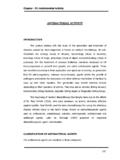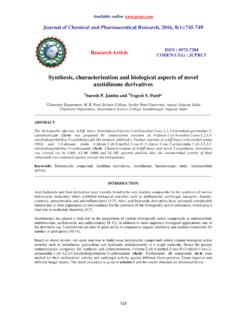Transcription of Macrobid (nitrofurantoin monohydrate/macrocrystals) …
1 This ART is to show size, copy placement and color breaks. Actual colors will bematched on press to approved color standards and/or PMS color cycles are NOT proof , proof readBEFORE authorizing Nosco to proceed tofinal check requestCustomer: Date:Another ART cycle required:Approved For Final Proofs: Macrobid ( nitrofurantoin monohydrate/macrocrystals) CapsulesTo reduce the development of drug-resistant bacteria and maintain the effectiveness of Macrobid and other antibacterial drugs, Macrobid should be used only to treat or prevent infections that are proven or strongly suspected to be caused by bacteria.
2 DESCRIPTION: nitrofurantoin is an antibacterial agent specific for urinary tract infections. The Macrobid brand of nitrofurantoin is a hard gelatin capsule shell containing the equivalent of 100 mg of nitrofurantoin in the form of 25 mg of nitrofurantoin macrocrystals and 75 mg of nitrofurantoin monohydrate. The chemical name of nitrofurantoin macrocrystals is 1-[[[5-nitro-2-furanyl]methylene]amino]- 2,4-imidazolidinedione. The chemical structure is the following:Molecular Weight: chemical name of nitrofurantoin monohydrate is 1-[[[5-nitro-2-furanyl]methylene]amino]- 2,4- imidazolidinedione monohydrate.
3 The chemical structure is the following:Molecular Weight: H2 OOInactive Ingredients: Each capsule contains carbomer 934P, corn starch, compressible sugar, D&C Yellow No. 10, edible gray ink, FD&C Blue No. 1, FD&C Red No. 40, gelatin, lactose, magnesium stearate, povidone, talc, and titanium dioxide. CLINICAL PHARMACOLOGY: Each Macrobid capsule contains two forms of nitrofurantoin . Twenty-five percent is macrocrystalline nitrofurantoin , which has slower dissolution and absorption than nitrofurantoin monohydrate.
4 The remaining 75% is nitrofurantoin monohydrate contained in a powder blend which, upon exposure to gastric and intestinal fluids, forms a gel matrix that releases nitrofurantoin over time. Based on urinary pharmacokinetic data, the extent and rate of urinary excretion of nitrofurantoin from the 100 mg Macrobid capsule are similar to those of the 50 mg or 100 mg Macrodantin ( nitrofurantoin macrocrystals) capsule. Approximately 20-25% of a single dose of nitrofurantoin is recovered from the urine unchanged over 24 nitrofurantoin concentrations after a single oral dose of the 100 mg Macrobid capsule are low, with peak levels usually less than 1 mcg/mL.
5 nitrofurantoin is highly soluble in urine, to which it may impart a brown color. When Macrobid is administered with food, the bioavailability of nitrofurantoin is increased by approximately 40%.MICROBIOLOGYN itrofurantoin is a nitrofuran antimicrobial agent with activity against certain Gram-positive and Gram-negative of ActionThe mechanism of the antimicrobial action of nitrofurantoin is unusual among antibacterials. nitrofurantoin is reduced by bacterial flavoproteins to reactive intermediates which inactivate or alter bacterial ribosomal proteins and other macromolecules.
6 As a result of such inactivations, the vital biochemical processes of protein synthesis, aerobic energy metabolism, DNA synthesis, RNA synthesis, and cell wall synthesis are inhibited. nitrofurantoin is bactericidal in urine at therapeutic doses. The broad-based nature of this mode of action may explain the lack of acquired bacterial resistance to nitrofurantoin , as the necessary multiple and simultaneous mutations of the target macromolecules would likely be lethal to the with Other AntibioticsAntagonism has been demonstrated in vitro between nitrofurantoin and quinolone antimicrobials.
7 The clinical significance of this finding is of ResistanceDevelopment of resistance to nitrofurantoin has not been a significant problem since its introduction in 1953. Cross-resistance with antibiotics and sulfonamides has not been observed, and transferable resistance is, at most, a very rare has been shown to be active against most strains of the following bacteria both in vitro and in clinical infections [see Indications and Usage):Aerobic and facultative Gram-positive microorganisms:Staphylococcus saprophyticusAerobic and facultative Gram-negative microorganisms.]
8 Escherichia coliAt least 90 percent of the following microorganisms exhibit an in vitro minimum inhibitory concentration (MIC) less than or equal to the susceptible breakpoint for nitrofurantoin . However, the efficacy of nitrofurantoin in treating clinical infections due to these microorganisms has not been established in adequate and well-controlled and facultative Gram-positive microorganisms:Coagulase-negative staphylococci (including Staphylococcus epidermidis)Enterococcus faecalisStaphylococcus aureusStreptococcus aga/actiaeGroup 0 streptococciViridans group streptococciAerobic and facultative Gram-negative microorganisms.
9 Citrobacter ama/onaticusCitrobacter diversusCitrobacter freundiiKlebsiella oxytocaKlebsiella ozaenaeNitrofurantoin is not active against most strains of Proteus species or Serratia species. It has no activity against Pseudomonas Test Methods:When available, the clinical microbiology laboratory should provide cumulative results of the in vitro susceptibility test results for antimicrobial drugs used in resident hospitals to the physician as periodic reports that describe the susceptibility profile of nosocomial and community-acquired pathogens.
10 These reports should aid the physician in selecting the most effective techniques: Quantitative methods are used to determine antimicrobial minimum inhibitory concentrations (MICs). These MICs provide estimates of the susceptibility of bacteria to antimicrobial compounds. The MICs should be determined using a standardized procedure. Standardized procedures are based on a dilution method (broth or agar) (1) or equivalent with standardized inoculum concentrations and standardized concentrations of nitrofurantoin powder.







